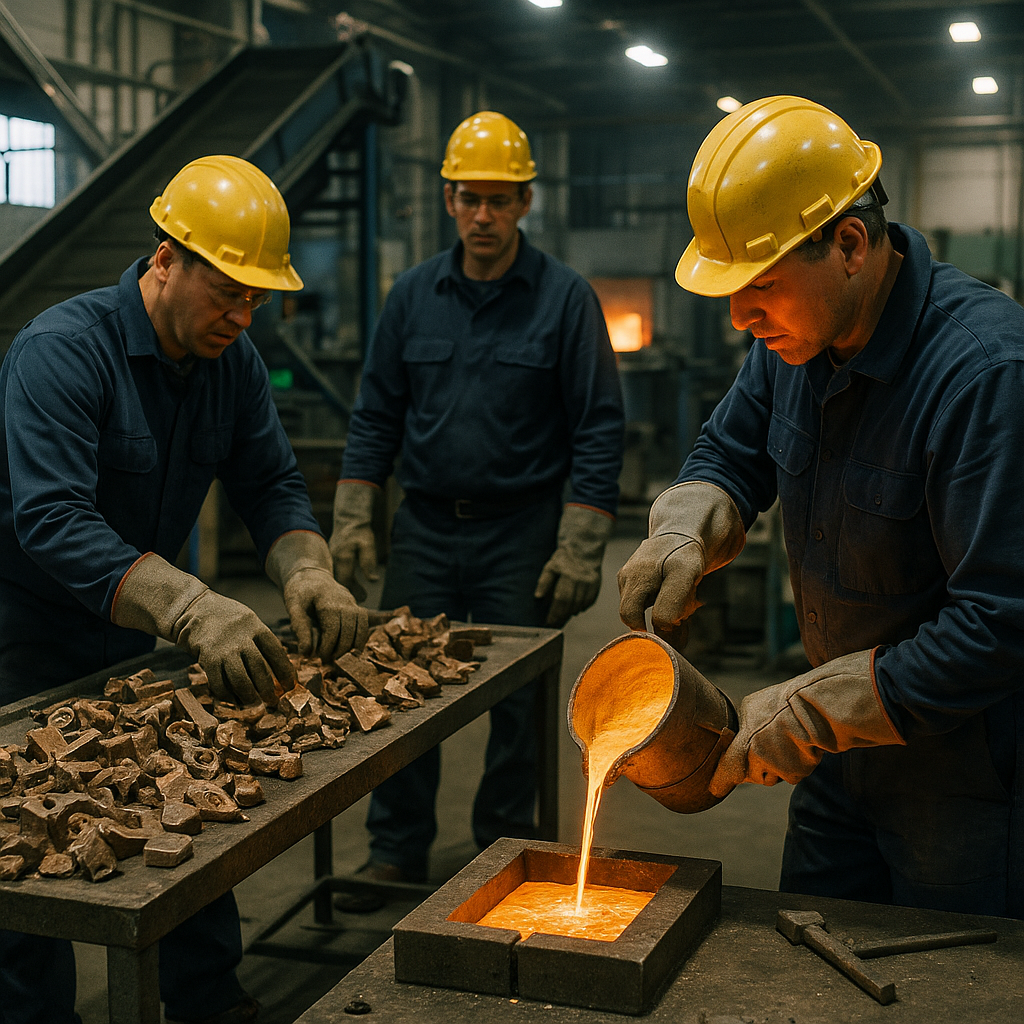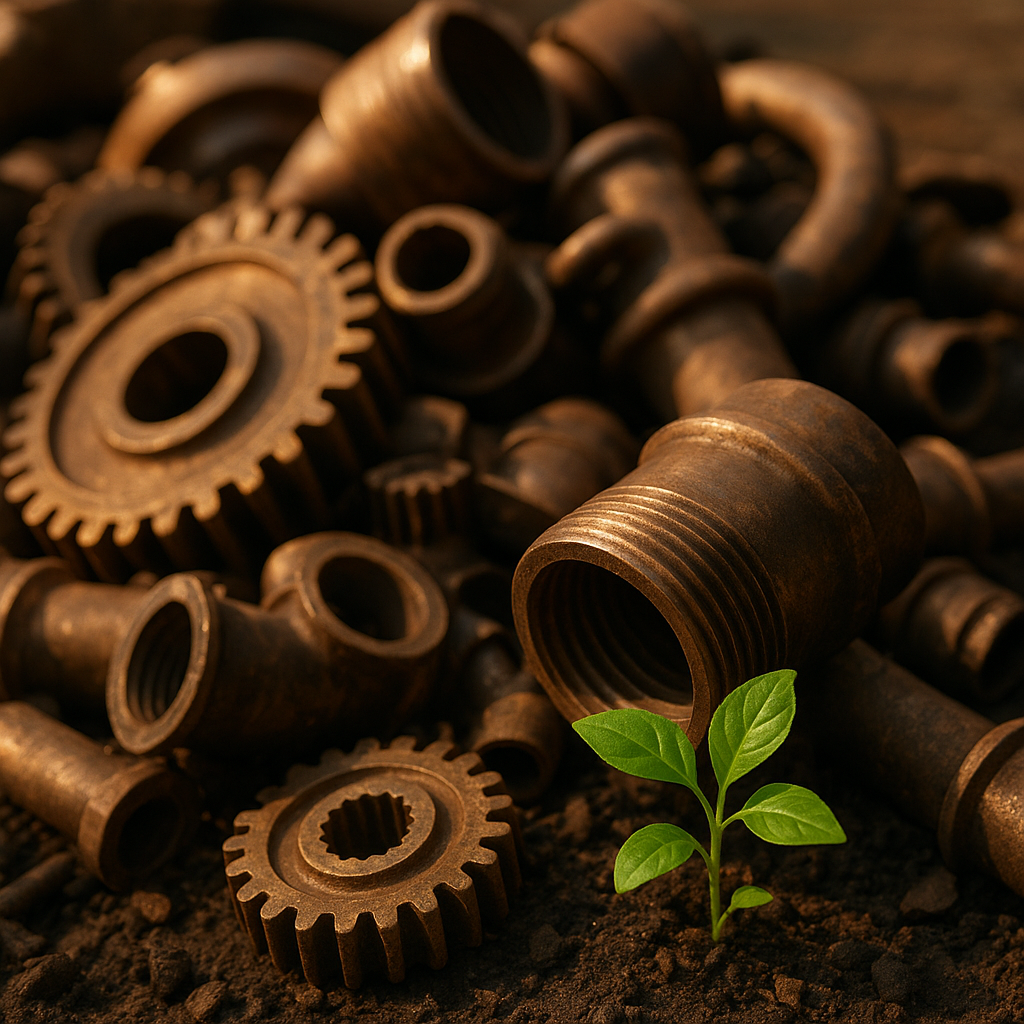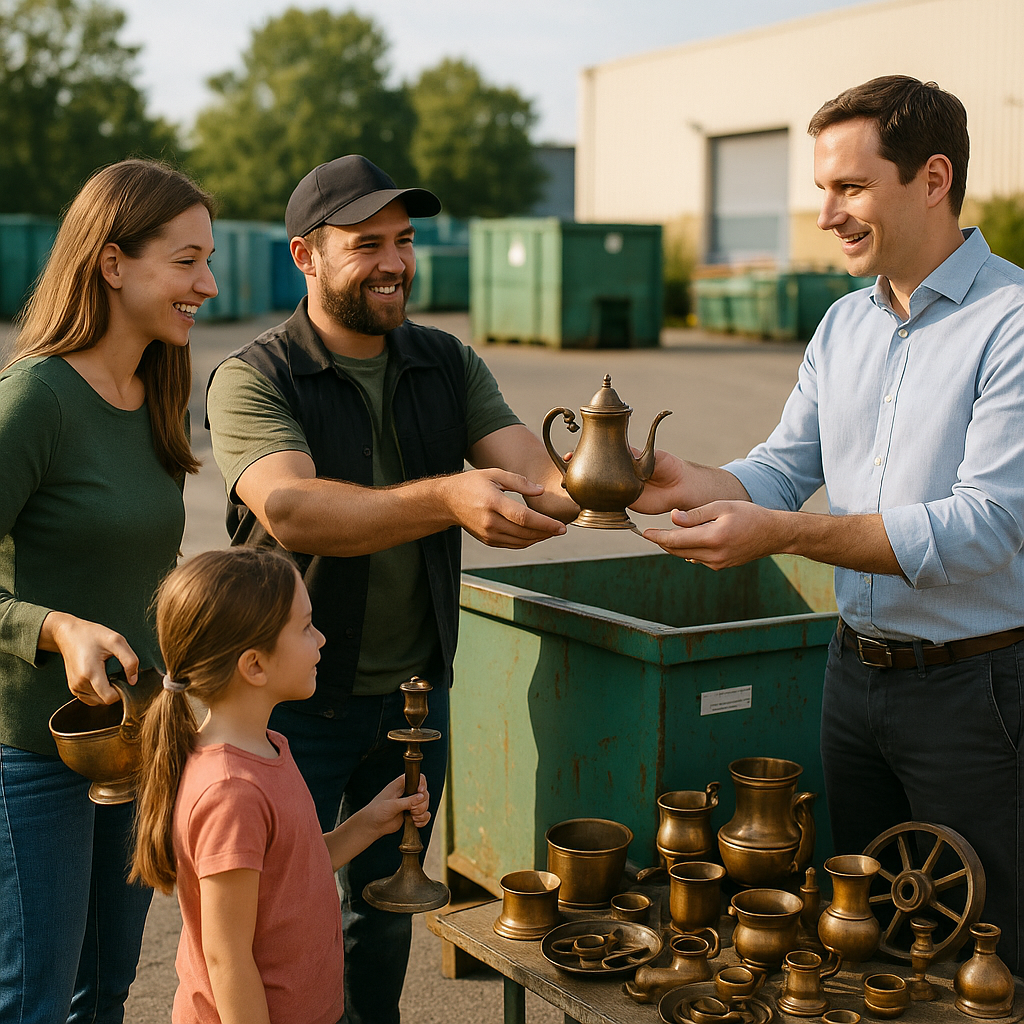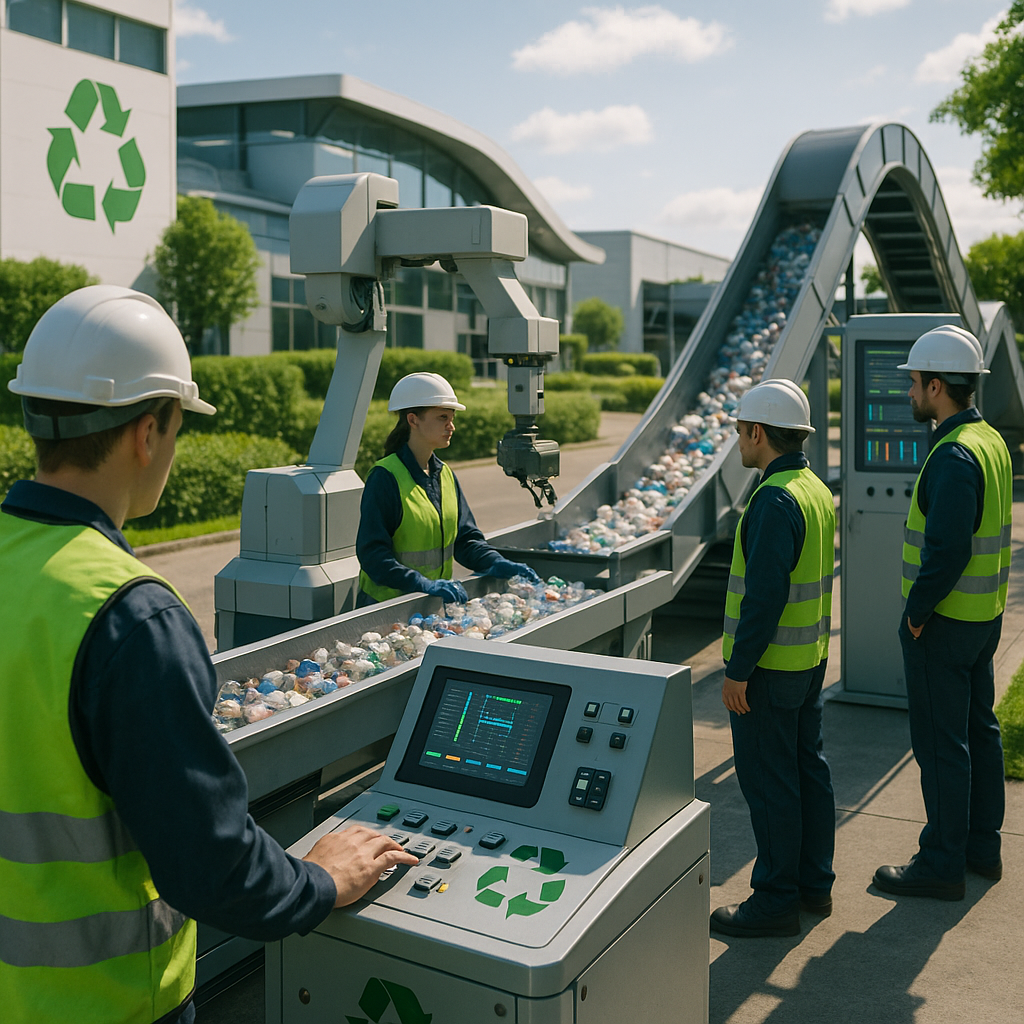5901 Botham Jean Blvd, Dallas, TX 75215
Bronze Recycling: Process, Benefits, and How to Recycle Effectively
October 9, 2025Bronze recycling involves collecting and processing scrap bronze materials to produce new bronze products. This sustainable practice prevents valuable metals from ending up in landfills and reduces the need for extracting virgin ore. Bronze is a versatile copper-based alloy composed primarily of copper and tin, with occasional additions of elements like zinc, aluminum, or phosphorus.
Known for its durability and corrosion resistance, bronze is used in many everyday applications. It can be found in sculptures, musical instruments such as cymbals and bells, bearings, bushings, and various industrial components. Its distinctive reddish-gold color and exceptional durability make it highly valued in both artistic and industrial contexts.
Recycling bronze is a vital part of modern resource conservation efforts. By recycling bronze, we preserve finite natural resources and significantly reduce energy consumption compared to primary metal production. This creates a sustainable cycle where bronze materials continue to provide value without depleting the earth’s resources or contributing to environmental degradation.
What Are the Steps in the Bronze Recycling Process?

The bronze recycling process transforms discarded bronze items into reusable metal through a series of specialized steps. Each stage is crucial to ensuring the final recycled product retains bronze’s desirable properties. Here’s a look at the complete process, from collection to final product.
1. Collection
The process starts with gathering scrap bronze from diverse sources. Individuals and businesses contribute old bronze fixtures, decorative items, industrial components, and musical instruments to recycling facilities. Collection points include scrap yards, municipal recycling centers, and industrial sites.
Commonly collected bronze components are plumbing fixtures, valves, doorknobs, statues, and mechanical parts. These items offer valuable recyclable material rather than waste destined for landfills.
2. Sorting and Separation
Once collected, the bronze is properly identified and separated from other metals. Recycling workers use techniques like magnet tests to distinguish bronze, which is non-magnetic, from ferrous metals like steel and iron.
Visual inspection helps identify bronze by its distinctive yellowish-brown color. Some facilities use advanced spectroscopy equipment to analyze metal composition accurately. This sorting stage is vital for ensuring high-quality recycled bronze.
3. Processing and Size Reduction
After sorting, bronze scrap undergoes processing to reduce its size. Large pieces are cut into smaller, manageable segments using industrial shears or torches. The material is then broken down further by shredders or granulators.
Size reduction serves two purposes: it makes the bronze easier to handle and increases its surface area for more efficient melting. Smaller pieces also allow more uniform heating during the melting phase.
4. Melting
The prepared bronze pieces enter a specialized furnace where they are heated to melting point. Bronze typically melts at temperatures between 1,675°F and 1,755°F (913°C to 957°C), depending on its exact composition. Precise temperature control is essential to prevent damage to the metal’s properties.
Furnaces used for bronze recycling range from small crucible furnaces to large industrial units. The melting stage transforms the solid scrap into liquid form, ready for purification.
5. Purification
Purification removes unwanted elements and contaminants from the molten bronze. This step ensures the recycled material meets quality standards. Impurities may include paint residues, oils, and non-compatible metals.
Recycling facilities use several purification methods. Some apply chemical agents to bind with impurities, creating slag that can be skimmed from the surface. Others use electrochemical processes to separate unwanted elements. The purification step determines the quality of the final recycled product.
6. Solidification
Once purified, the molten bronze cools and solidifies into new forms. Depending on its intended use, the recycled bronze might be cast into ingots, bars, sheets, or customized shapes. These standardized forms make storage, transportation, and subsequent manufacturing processes more efficient.
The solidification process often involves pouring the liquid bronze into molds or onto conveyor systems that cool the metal under controlled conditions. The cooling rate affects the material’s final properties, so this step requires careful monitoring.
After solidification, the recycled bronze is ready to begin its new life in manufacturing, potentially creating new bronze products without quality loss compared to virgin bronze.
7. Quality Control
The final step involves testing the recycled bronze to verify its composition and properties. Quality control ensures the material meets industry specifications. Tests analyze the bronze’s strength, hardness, corrosion resistance, and exact alloy composition.
Only after passing quality tests is the recycled bronze distributed to manufacturers for use in new products. This verification maintains confidence in recycled materials and ensures reliable performance in new applications.
The complete bronze recycling process creates a sustainable loop that conserves natural resources, reduces energy consumption, and minimizes waste. Each recycled bronze item provides raw material for new products without the environmental impact of mining and processing virgin metals.
| Process Step | Details |
| Collection | Gathering scrap bronze from sources such as old fixtures, decorative items, and industrial components |
| Sorting and Separation | Distinguishing bronze from other metals using magnet tests and visual inspection |
| Processing and Size Reduction | Cutting and shredding bronze into smaller, manageable pieces |
| Melting | Heating bronze to 1,675°F – 1,755°F in furnaces to transform it into liquid form |
| Purification | Removing impurities using chemical agents or electrochemical processes |
| Solidification | Casting the purified bronze into new forms like ingots or sheets |
| Quality Control | Testing the recycled bronze to ensure it meets specification standards |
What Are the Benefits of Recycling Bronze?

Recycling bronze delivers significant environmental and economic benefits, extending far beyond just reducing waste. Bronze, an alloy typically made of copper and tin, can be recycled repeatedly without losing its valuable properties, making it an ideal material for sustainable resource management.
Resource Conservation
Recycling bronze reduces the need for raw material extraction. Mining for copper and tin can cause substantial environmental disruption through habitat destruction and landscape alteration. Each ton of recycled bronze preserves these finite natural resources for future generations.
Bronze recycling also protects ecosystems from harmful chemicals used in ore extraction, which can contaminate water sources and disrupt aquatic life. By choosing recycled bronze, we prevent this contamination, helping to safeguard natural habitats.
Preserving raw materials through recycling is a critical step towards sustainable resource management. As global demand for metals rises, recycling bronze ensures these valuable resources remain available for essential uses.
Energy Savings and Reduced Emissions
The energy required to recycle bronze is substantially less than processing new bronze from virgin materials. Recycling bronze can save up to 90% of the energy needed for production from raw ore, leading to significant reductions in fossil fuel consumption.
These energy savings are directly linked to decreased carbon emissions. The reduced energy requirements mean fewer greenhouse gases released into the atmosphere. The metal recycling process produces significantly less carbon dioxide and other harmful pollutants compared to primary production.
Lower emissions contribute to climate change mitigation efforts. With growing concerns about global warming, bronze recycling provides a practical way for industries to reduce their carbon footprint.
| Material | Energy Savings | CO2 Emissions Reduction |
| Bronze | Up to 90% compared to using virgin materials | Significant reduction in greenhouse gases |
| Aluminum | 95% compared to producing from bauxite | Prevents emission of 9 tons CO2 per ton recycled |
| Steel | 60% to 70% less energy required than new steel | Reduces CO2 emissions by 2 tons per ton recycled |
| Copper | Approximately 85% energy savings | Prevents emission of up to 3.5 tons CO2 per ton recycled |
Landfill Waste Reduction
Bronze items discarded in landfills do not decompose, occupying valuable space indefinitely and potentially leaching harmful substances into the surrounding soil. Recycling bronze diverts these materials from landfills.
This diversion supports waste management goals and reduces the need for new landfill space. Communities benefit from lower waste management costs and decreased environmental impacts associated with landfill expansion.
Bronze recycling contributes to the circular economy model. Instead of the traditional take-make-dispose approach, recycled bronze feeds back into production systems, creating a sustainable materials cycle.
Economic Benefits
The bronze recycling industry creates jobs at various skill levels. From collection and sorting to processing and manufacturing with recycled materials, employment opportunities span the entire recycling value chain.
Manufacturers using recycled bronze often enjoy cost savings. With lower energy requirements and processing costs, recycled bronze can be more economical than virgin materials. These savings may be passed down to consumers through competitive pricing.
Local economies benefit from recycling infrastructure. Recycling centers contribute to the tax base and often support other businesses in their communities. The economic activity generated through metal recycling extends well beyond the recycling facilities themselves.
Market Stability
Recycling bronze helps stabilize metal markets by reducing dependence on raw material extraction. This stability benefits manufacturers by allowing more effective planning with consistent material costs.
The recycling industry creates resilience against supply chain disruptions. When geopolitical issues or natural disasters affect mining operations, recycled materials help maintain supply continuity.
Bronze recycling supports industrial self-sufficiency. Countries with limited natural resources can reduce import dependencies through robust recycling programs, strengthening their manufacturing sectors.
By embracing bronze recycling, we participate in creating a more sustainable, resource-efficient future. The environmental and economic benefits combine to make recycling not just an environmental choice but a practical and financially sound decision.
How Can Individuals and Businesses Participate in Bronze Recycling?

Participating in bronze recycling is simple for both individuals and businesses. Bronze items are common in many homes and commercial settings. Old plumbing fixtures, decorative objects, hardware components, and musical instruments often contain valuable bronze that can be recycled instead of being sent to landfills.
Identifying Bronze Items for Recycling
The first step in bronze recycling is identifying items containing this valuable alloy. Look for objects with a reddish-brown or golden color. Common household bronze items include doorknobs, light fixtures, plumbing fittings, and decorative pieces. For businesses, bronze may be found in machinery parts, valves, or connectors.
A simple test to identify bronze is checking if a magnet sticks to the metal. Since bronze is non-ferrous, it will not be magnetic, unlike steel or iron, which require different recycling processes.
Check your storage areas, garages, basements, and workshops for unused or broken bronze items. Renovation projects often yield significant amounts of recyclable bronze from old fixtures and hardware.
Separating Bronze from Other Materials
Proper sorting enhances the value and recyclability of your bronze. Keep bronze items separate from other metals in your collection. Many recycling facilities offer higher rates for pre-sorted materials due to reduced processing costs.
Remove any non-metal attachments from your bronze items, such as plastic handles, rubber grips, and wooden components. The purer the bronze scrap, the more valuable it is in the recycling stream.
For businesses that regularly generate bronze waste, setting up dedicated collection containers where scrap is generated can streamline the process. Clearly labeling these containers helps ensure proper sorting by employees.
Finding Local Recycling Options
Most communities have several options for recycling bronze. Local scrap yards and metal recycling centers typically accept bronze alongside other non-ferrous metals. Search online directories or contact your local waste management department to find facilities nearby.
For individuals with smaller amounts of bronze, community recycling events can be convenient opportunities for responsible disposal. These events are often advertised on local government websites or community boards.
Businesses with larger quantities may benefit from establishing relationships with recycling facilities that offer pickup services. Many recyclers provide transportation for substantial loads, making the process more convenient for commercial operations.
| Source | Common Bronze Items |
|---|---|
| Household | Doorknobs, decorative fixtures, some tools |
| Industrial | Plumbing valves, mechanical parts, bushings |
| Construction | Older plumbing components |
Preparing Bronze Items for Recycling
Preparation is vital to maximizing environmental benefits and financial returns from bronze recycling. Clean your bronze items to remove dirt, grease, or other contaminants. Even a simple rinse can improve their quality and value.
For larger items, disassembly may be necessary. Remove any non-bronze components to ensure you are recycling pure materials. This process also simplifies transportation and may increase the price received.
Drain all fluids from any bronze components that might have contained liquids. This is especially important for plumbing fixtures or automotive parts to prevent environmental contamination during transport and processing.
Understanding the Value of Bronze Scrap
Bronze recycling can offer financial returns. The value of bronze scrap depends on market conditions, alloy composition, and purity. Clean, well-sorted bronze typically commands higher prices than mixed or contaminated materials.
When taking bronze to recycling facilities, inquire about their payment structures. Some may offer cash payments based on weight and quality, while others might provide discount vouchers or credits toward other services.
For businesses, tracking the volume and value of recycled bronze can offer insights into waste reduction efforts and potential revenue streams. This data can support sustainability reporting and help identify opportunities for process improvements.
Establishing Ongoing Recycling Practices
Consistent participation in bronze recycling provides the greatest benefits. For individuals, setting up a designated area for collecting metal scrap makes it easier to accumulate enough material to justify a trip to the recycling facility.
Businesses can develop formal recycling programs with clear guidelines for employees. Training staff on identifying and handling recyclable bronze ensures valuable materials do not end up in general waste streams.
Consider partnering with recycling facilities that provide detailed reports on recycled materials. These reports can help track progress toward sustainability goals and demonstrate environmental commitment to customers and stakeholders.
Conclusion: The Future of Bronze Recycling

Bronze recycling plays a crucial role in both environmental preservation and economic growth. It dramatically reduces energy consumption, as recycled bronze requires only a small portion of the energy needed to extract and process new copper and tin. This energy efficiency leads to lower greenhouse gas emissions and a decreased environmental footprint.
The industry creates valuable jobs in collection, transportation, processing, and manufacturing while preventing materials from ending up in landfills. With ongoing technological innovations improving sorting processes and metal recovery rates, the industry’s efficiency continues to grow. This evolution positions bronze recycling as a key element of the circular economy, where materials retain their value through multiple life cycles.
For expert advice on recycling bronze and other valuable metals, contact Okon Recycling at 214-717-4083. Our team can help you realize both the environmental and economic benefits of your recycling efforts.
